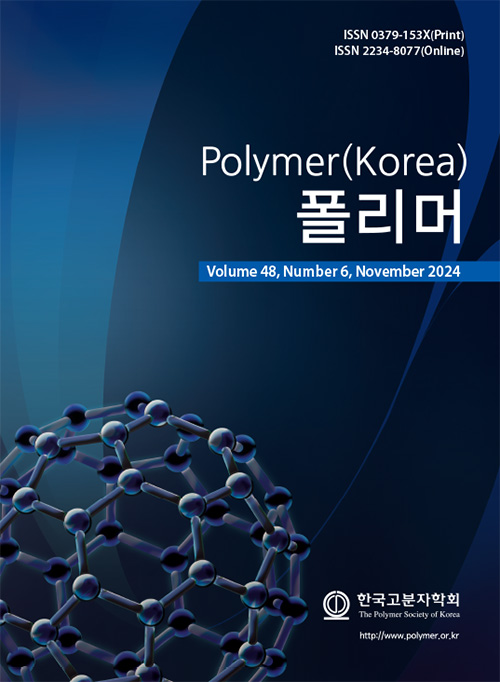- Optimization Study on Vacuum-free Fabrication of OLEDs with Hybrid Electrodes by Using Thermal Behavior of Polymers
Hyuckjin Nam, Boeun Ryu, Seo Yeong Son, Seong Yeon Park, and Changhun Yun†

School of Polymer Science and Engineering, Chonnam National University, Gwangju 61186, Korea
- 고분자의 온도별 특성을 이용한 하이브리드 전극 기반 무진공 OLED 제조 공정 최적화 연구
전남대학교 고분자융합소재공학부
Reproduction, stored in a retrieval system, or transmitted in any form of any part of this publication is permitted only by written permission from the Polymer Society of Korea.
This study investigates the junction mechanism between a hybrid electrode and the underlying light-emitting polymer PDY-132, used in organic light emitting diode (OLED) devices, to enhance the device efficiency using the vacuum-free fabrication. The impact of glass transition temperature of polymeric layers such as ethylene vinyl acetate (EVA) used in hybrid electrode fabrication, poly(3,4-ethylenedioxythiophene):poly(4-styrenesulfonate) (PEDOT:PSS) utilized as a hole-injection layer, and PDY-132 (super yellow) employed in the emissive layer was investigated on the current flow and the device efficiency, depending on the process temperature. Consequently, the optimized vacuum-free fabrication of OLEDs introduced the turn-on voltage below 3 V and the external quantum efficiency over 3.0%, which were comparable with device performance of the conventional OLED device fabricated under ultra-high vacuum ambient.
본 연구는 무진공 제조 공정을 이용하여 제작된 유기 발광 다이오드(OLED) 소자의 효율 향상을 위하여, 하이브리드 전극과 발광층으로 사용되는 고분자(PDY-132)간의 공정 온도에 따른 접합 메커니즘 변화를 연구하였다. 하이브리드 전극 제조에 사용되는 ethylene vinyl acetate(EVA), 정공 주입 층으로 사용되는 poly(3,4-ethylenedioxythiophene): poly(4-styrenesulfonate)(PEDOT:PSS) 그리고 발광층으로 사용되는 PDY-132(super yellow)의 유리 전이 온도의 영향으로, 공정 온도에 따른 접합 양상의 변화가 OLED 소자의 전류의 흐름을 방해하여 소자 효율에 미치는 영향을 확인하였다. 이로써 무진공 OLED 제조 공정 최적화를 통하여, OLED 소자의 turn-on 전압을 3 V 이내로 앞당겼고 OLED의 발광효율을 나타내는 외부 양자 효율을 3.0% 이상으로 향상시키는 데 성공하였다.
Keywords: organic light emitting diode, hybrid electrode, ethylene vinyl acetate, poly(3,4-ethylenedioxythiophene):poly(4-styrenesulfonate), super yellow, glass transition temperature.
- Polymer(Korea) 폴리머
- Frequency : Bimonthly(odd)
ISSN 0379-153X(Print)
ISSN 2234-8077(Online)
Abbr. Polym. Korea - 2023 Impact Factor : 0.4
- Indexed in SCIE
 This Article
This Article
-
2024; 48(6): 656-661
Published online Nov 25, 2024
- 10.7317/pk.2024.48.6.656
- Received on Jun 7, 2024
- Revised on Jul 17, 2024
- Accepted on Jul 18, 2024
 Correspondence to
Correspondence to
- Changhun Yun
-
School of Polymer Science and Engineering, Chonnam National University, Gwangju 61186, Korea
- E-mail: chyun2020@jnu.ac.kr








 Copyright(c) The Polymer Society of Korea. All right reserved.
Copyright(c) The Polymer Society of Korea. All right reserved.